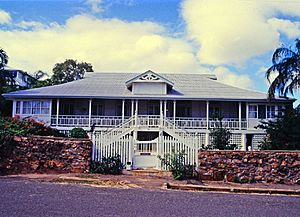Selhurst, North Ward facts for kids
Quick facts for kids Selhurst, North Ward |
|
|---|---|

Selhurst
|
|
| Location | 24 Cleveland Terrace, North Ward, City of Townsville, Queensland, Australia |
| Design period | 1914 - 1919 (World War I) |
| Built | 1919 |
| Official name: Selhurst | |
| Type | state heritage (built) |
| Designated | 30 May 2003 |
| Reference no. | 601247 |
| Significant period | 1919 (fabric, historical) |
| Significant components | residential accommodation - manager's house/quarters, ballroom, roof/ridge ventilator/s / fleche/s, views to, fence/wall - perimeter, garden/grounds, views from |
| Lua error in Module:Location_map at line 420: attempt to index field 'wikibase' (a nil value). | |
Selhurst is a historic house located at 24 Cleveland Terrace in North Ward, Townsville, Queensland, Australia. It was built in 1919 and is a special part of Queensland's history. The house was added to the Queensland Heritage Register on May 30, 2003, which means it is protected for its historical importance.
Contents
A Look Back: Selhurst's Story
Selhurst was built in 1919. It was likely designed by Townsville architect Walter Hunt. The house was made for John Alexander Carpenter. He was the manager in Townsville for a very important company called Burns Philp.
The Burns Philp Company
The Burns Philp Company was started by James Burns in Townsville in 1872. It began as a business that sold goods to gold fields and remote farms. In 1874, Robert Philp joined Burns. They became partners in 1876.
The company grew very big. It became a major player in trade across North Queensland and the Pacific Ocean. Their success was linked to the mining, farming, and sugar industries in North Queensland.
For a short time in the 1880s, Burns Philp was involved in bringing Pacific Islanders to Australia. These people worked as laborers, mostly on sugar plantations. The company stopped this practice after some issues in 1884.
By the 1890s, Burns Philp had many branches. They were in places like Cairns, Charters Towers, Cooktown, and Brisbane. They also became shipping agents, helping other companies transport mail and goods.
Robert Philp's Political Journey
While in Townsville, Robert Philp became interested in politics. He wanted to expand the railway and create a separate state in North Queensland. He was elected to the Queensland government in 1886. Philp later became the Premier (the leader of the state) twice, first in 1899 and again in 1907. He stayed in politics until 1915.
Selhurst's Owners
After Robert Philp entered politics, other managers took over the Townsville branch of Burns Philp. John Alexander Carpenter was a very successful manager of the Cairns branch. In 1914, he moved to Townsville to manage the office there.
Carpenter bought land on Melton Hill in 1914. The first house on the property was destroyed by fire. Selhurst was built in 1919 as the second house. When John Alexander Carpenter moved to New Zealand in 1919, Burns Philp Company bought Selhurst. It became the home for their managers until 1976.
Melton Hill was a popular place for important people to live. Many managers, lawyers, and doctors built their homes there. Selhurst is one of several important old houses still standing on Cleveland Terrace.
What Selhurst Looks Like
Selhurst sits high up on Melton Hill. It faces east, looking out towards the Pacific Ocean. It is a single-story house with wide verandahs on three sides.
The roof is made of corrugated iron. It has a special raised part with vents to help keep the house cool inside. The house has a timber fence-like base and wooden railings on the verandahs. The front of Selhurst has decorative panelled doors.
Inside, there is a central hallway. Rooms open off to both sides. At the back of the house, there was once a small ballroom. This room has now been changed into a family room.
The house is built on a flat area cut into the hillside. The land rises behind the house. Selhurst is surrounded by gardens. There is a large rock wall and an ivy hedge at the front. This wall might be a part of a very old wall built around 1865.
Palm trees are planted around the house, giving it a tropical feel. There is also a swimming pool with a white fence. Selhurst is one of only a few houses of its kind left in Townsville. It is the only one with this exact design.
Why Selhurst is Important
Selhurst is listed on the Queensland Heritage Register because it meets certain important standards.
A Piece of Queensland's History
Selhurst was built in 1919 for the Burns Philp Company's manager. It shows how important this company was to Queensland's economy. The house helps us understand the history of trade and business in North Queensland.
Beautiful Design
Selhurst is a great example of an early North Queensland house style. It is one of many beautiful old homes on Cleveland Terrace. Its design, size, and materials make it a special part of the Melton Hill area. It stands out alongside other historic buildings like St James Cathedral.
Connected to Important People
The house was home to Burns Philp managers for 57 years. It is also believed to be a work of the famous Townsville architect, Walter Hunt. This connection makes Selhurst important to Queensland's history.

